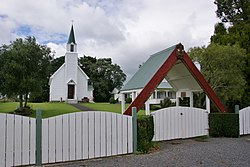Te Puna
Te Puna | |
|---|---|
 St Joseph's Church | |
 | |
| Coordinates: 37°41′45″S 176°04′22″E / 37.695823°S 176.072806°ECoordinates: 37°41′45″S 176°04′22″E / 37.695823°S 176.072806°E | |
| Country | New Zealand |
| Region | Bay of Plenty |
| Territorial authority | Tauranga City |
| Population (2018) | |
| • Total | 2,262 |
Te Puna is a rural community near Tauranga in the Bay of Plenty region of New Zealand's North Island. It is located on State Highway 2, north of Bethlehem and south of Katikati.
The local Te Puna Quarry has been redeveloped by volunteers into a park.[1]
Te Puna has three marae belonging to the Ngāti Ranginui hapū of Pirirākau:[2] Paparoa Marae and Werahiko meeting house, Poutūterangi Marae and Takurua meeting house, and Tutereinga Marae and meeting house.[3]
Politician Todd Muller was raised in Te Puna in the 1970s, where his parents started a kiwifruit orchard.[4] He attended Te Puna Primary School.[5] He entered Parliament at the 2014 general election as the MP for Bay of Plenty, and was National Party leader and the Leader of the Opposition from 22 May to 14 July 2020.[6]
Demographics[]
| Year | Pop. | ±% p.a. |
|---|---|---|
| 2006 | 2,004 | — |
| 2013 | 2,013 | +0.06% |
| 2018 | 2,262 | +2.36% |
| Source: [7] | ||
Te Puna had a population of 2,262 at the 2018 New Zealand census, an increase of 249 people (12.4%) since the 2013 census, and an increase of 258 people (12.9%) since the 2006 census. There were 744 households. There were 1,161 males and 1,101 females, giving a sex ratio of 1.05 males per female. The median age was 45.2 years (compared with 37.4 years nationally), with 435 people (19.2%) aged under 15 years, 375 (16.6%) aged 15 to 29, 1,110 (49.1%) aged 30 to 64, and 342 (15.1%) aged 65 or older.
Ethnicities were 74.3% European/Pākehā, 32.5% Māori, 1.9% Pacific peoples, 2.4% Asian, and 0.9% other ethnicities (totals add to more than 100% since people could identify with multiple ethnicities).
The proportion of people born overseas was 13.4%, compared with 27.1% nationally.
Although some people objected to giving their religion, 43.4% had no religion, 43.5% were Christian, 0.3% were Hindu, 0.7% were Buddhist and 5.6% had other religions.
Of those at least 15 years old, 396 (21.7%) people had a bachelor or higher degree, and 225 (12.3%) people had no formal qualifications. The median income was $36,400, compared with $31,800 nationally. The employment status of those at least 15 was that 933 (51.1%) people were employed full-time, 369 (20.2%) were part-time, and 54 (3.0%) were unemployed.[7]
Education[]
Te Puna School is a co-educational state primary school for Year 1 to 8 students,[8][9] with a roll of 270 as of November 2021.[10]
References[]
- ^ "Te Puna Quarry Park Open all day, every day. Free admission". quarrypark.org.nz. Te Puna Quarry Park.
- ^ "Te Kāhui Māngai directory". tkm.govt.nz. Te Puni Kōkiri.
- ^ "Māori Maps". maorimaps.com. Te Potiki National Trust.
- ^ Braae, Alex (15 September 2019). "The increasingly uncompromising Todd Muller". The Spinoff. Retrieved 28 May 2020.
- ^ Braae, Alex. "Here's what you need to know about new National leader Todd Muller". The Spinoff.
- ^ Ensor, Jamie (14 July 2020). "Live updates: Todd Muller resigns as National Party leader". Newshub. Retrieved 14 July 2020.
- ^ a b "Statistical area 1 dataset for 2018 Census". Statistics New Zealand. March 2020. Te Puna (191200). 2018 Census place summary: Te Puna
- ^ "Te Puna School Official School Website". tepuna.school.nz.
- ^ "Te Puna School Ministry of Education School Profile". educationcounts.govt.nz. Ministry of Education.
- ^ "Te Puna School Education Review Office Report". ero.govt.nz. Education Review Office.
- Suburbs of Tauranga
- Populated places around the Tauranga Harbour
